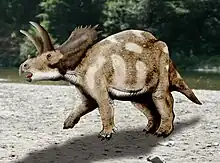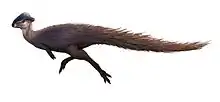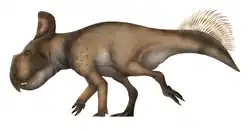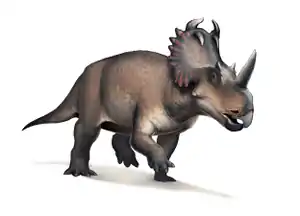| Coahuilaceratops Temporal range: Late Cretaceous ~ | |
|---|---|
 | |
| Skull of Coahuilaceratops | |
| Scientific classification | |
| Domain: | Eukaryota |
| Kingdom: | Animalia |
| Phylum: | Chordata |
| Clade: | Dinosauria |
| Clade: | †Ornithischia |
| Suborder: | †Ceratopsia |
| Family: | †Ceratopsidae |
| Subfamily: | †Chasmosaurinae |
| Genus: | †Coahuilaceratops Loewen et al., 2010 |
| Species: | †C. magnacuerna |
| Binomial name | |
| †Coahuilaceratops magnacuerna Loewen et al., 2010 | |
Coahuilaceratops (meaning "Coahuila horn face") is a genus of ceratopsian dinosaur. It is a chasmosaurine ceratopsian which lived during the Late Cretaceous period (late Campanian stage) in what is now southern Coahuila in northern Mexico. It is known from the holotype CPC 276, a partial skeleton of an adult individual which includes several skull elements. Another specimen, CPS 277, may represent a juvenile Coahuilaceratops. All specimens of Coahuilaceratops were collected from a single location in the middle strata of the Cerro del Pueblo Formation, which dates to between 72.5 and 71.4 million years ago.[1]

It was formally described in 2010, though it appeared as an informal designation (nomen nudum) as early as 2008.[2] Coahuilaceratops was named by Mark A. Loewen, Scott D. Sampson, Eric K. Lund, Andrew A. Farke, Martha C. Aguillón Martínez, C.A. de León, R.A. Rodríguez de la Rosa, Michael A. Getty and David A. Eberth in 2010 and the type species is Coahuilaceratops magnacuerna.[1] Although based on incomplete remains, Coahuilaceratops is thought to possess among the largest horns of any dinosaur currently known, rivaling in absolute size those of larger chasmosaurines like Triceratops and Torosaurus. Its horns are estimated to have been up to 1.2 m (4 feet) long.[3][1] It was a medium-sized ceratopsian, reaching 4 metres (13 ft) in length and 1 metric ton (1.1 short tons) in body mass.[4]
Systematics
Coahuilaceratops is a member of the Chasmosaurinae. Below is a cladogram that represents the findings of Caleb Brown and Donald Henderson (2015), finding Coahuilaceratops to be the sister taxon to the Texan Bravoceratops.[5]
| Chasmosaurinae |
| ||||||||||||||||||||||||||||||||||||||||||||||||||||||||||||||||||||||||||||||||||||||||||||||||||||||||||||||||||||||||
This pairing was replicated by Jordan Mallon et al. in 2016, although Bravoceratops had to be cut from the analysis to create meaningful results. [6] In 2021, Sierraceratops was described and found to clade with Coahuilaceratops and Bravoceratops, and its describers, Sebastian Dalman et al., suggest they all form a clade unique to southern Laramidia.[7]
See also
References
- 1 2 3 Loewen, M.A., Sampson, S.D., Lund, E.K., Farke, A.A., Aguillón-Martínez, M.C., de Leon, C.A., Rodríguez-de la Rosa, R.A., Getty, M.A., Eberth, D.A., 2010, "Horned Dinosaurs (Ornithischia: Ceratopsidae) from the Upper Cretaceous (Campanian) Cerro del Pueblo Formation, Coahuila, Mexico", In: Michael J. Ryan, Brenda J. Chinnery-Allgeier, and David A. Eberth (eds), New Perspectives on Horned Dinosaurs: The Royal Tyrrell Museum Ceratopsian Symposium, Indiana University Press, 656 pp.
- ↑ González, Edgar (2008-11-20). "Hallan en Coahuila nuevo dinosaurio". Vanguardia (in Spanish). Archived from the original on 2013-01-12. Retrieved 2009-10-11.
- ↑ http://www.eurekalert.org/pub_releases/2010-05/uou-fhd052510.php eurekalert - First horned dinosaur from Mexico
- ↑ Paul, Gregory S. (2016). The Princeton Field Guide to Dinosaurs. Princeton University Press. p. 293. ISBN 978-1-78684-190-2. OCLC 985402380.
- ↑ Brown, Caleb M.; Henderson, Donald M. (June 4, 2015). "A new horned dinosaur reveals convergent evolution in cranial ornamentation in ceratopsidae". Current Biology. 25 (12): 1641–8. doi:10.1016/j.cub.2015.04.041. PMID 26051892.
- ↑ Jordan C. Mallon; Christopher J. Ott; Peter L. Larson; Edward M. Iuliano; David C. Evans (2016). "Spiclypeus shipporum gen. et sp. nov., a Boldly Audacious New Chasmosaurine Ceratopsid (Dinosauria: Ornithischia) from the Judith River Formation (Upper Cretaceous: Campanian) of Montana, USA". PLOS ONE. 11 (5): e0154218. Bibcode:2016PLoSO..1154218M. doi:10.1371/journal.pone.0154218. PMC 4871577. PMID 27191389.
- ↑ Dalman, Sebastian G.; Lucas, Spencer G.; Jasinski, Steven E.; Longrich, Nicholas R. (2021-09-29). "Sierraceratops turneri, a new chasmosaurine ceratopsid from the Hall Lake Formation (Upper Cretaceous) of south-central New Mexico". Cretaceous Research. 130: 105034. doi:10.1016/j.cretres.2021.105034. ISSN 0195-6671. S2CID 244210664.

.png.webp)


